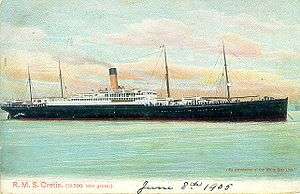SS Cretic
SS Cretic was an ocean liner built in 1902. She was operated by several shipping lines, all of which were part of the International Mercantile Marine Company, under several names during her career, which came to an end when she was scrapped in 1929.
 Postcard of SS Cretic, 1905 | |
| History | |
|---|---|
| Name: |
|
| Owner: | International Mercantile Marine Company |
| Operator: |
|
| Port of registry: | Liverpool |
| Builder: | R & W Hawthorn, Leslie & Co. Ltd., Hebburn[1] |
| Yard number: | 381[1] |
| Launched: | 25 February 1902[1] |
| Completed: | June 1902[1] |
| In service: | 19 July 1902[2] |
| Out of service: | September 1928[2] |
| Identification: |
|
| Fate: | Broken up, 1929[1] |
| General characteristics [1] | |
| Type: | Ocean liner |
| Tonnage: | |
| Length: | 582 ft (177 m) |
| Beam: | 60 ft 4 in (18.39 m) |
| Depth: | 38 ft 4 in (11.68 m) |
| Propulsion: | 2 × 3-cylinder triple expansion steam engines, 1,269 nhp, 2 screws |
| Speed: | 15 knots (28 km/h; 17 mph)[2] |
| Capacity: |
|
Ship history
The steel-hulled ship was built by R & W Hawthorn, Leslie & Co. Ltd. of Hebburn for Frederick Leyland & Co. and launched on 25 February 1902 as SS Hanoverian. The 13,507-ton ship was 582 feet long, and 60 feet in the beam. She was powered by two 3-cylinder triple expansion steam engines, delivering 1,269 nhp to two screws.[1]
In July 1902 she entered service in the Leyland Line,[1] but made only three voyages between Liverpool and Boston before the company became part of the International Mercantile Marine Company in October 1902.[4]
Hanoverian was transferred to the Dominion Line and renamed SS Mayflower, entering service between Liverpool and Boston in April 1903.[2] In November 1903 she was transferred again, this time to the Oceanic Steam Navigation Company's White Star Line, and was renamed SS Cretic.[2] Initially remaining on the Liverpool-Boston route, in November 1904 she was transferred to routes between the Mediterranean and New York City, finally returning to the Liverpool-Boston route in 1910.[2]
In 1917 she was taken over by the British government under their Liner Requisition Scheme to serve as a troopship during World War I.[2] On 5 April 1918 Cretic, Lapland, and Justicia sailed from Long Island City, New York, with the three battalions of the U.S. 308th Infantry Regiment aboard. On Cretic, the 2,032 men of the 2nd Battalion found that there was only accommodation for 1,500, so the troops were forced to eat and sleep in shifts until arriving at Liverpool on 19 April.[5]
Cretic returned to commercial service in September 1919 on the White Star Line's Mediterranean service.[2] In 1923 Cretic was transferred back to the Leyland Line, and renamed SS Devonian[1] served on the Liverpool-Boston route until the end of her career in September 1928, apart from making three voyages under charter to the Red Star Line from Antwerp to New York in 1927-28.[2] In 1929 she was broken up by P & W McLellan of Bo’ness, Scotland.[1]
References
- "Hanoverian (1902)". tynebuiltships.co.uk. 2012. Retrieved 19 November 2012.
- Clarkson, Andrew (2012). "Cretic". titanic-titanic.com. Retrieved 19 November 2012.
- Solem, Borge (2012). "Cretic, White Star Line". norwayheritage.com. Retrieved 19 November 2012.
- "The White Star Line: Cretic". The Merchant Navy Association. 2010. Archived from the original on 3 March 2013. Retrieved 19 November 2012.
- Miles, L. Wardlaw (2005). "History of the 308th Infantry". longwood.k12.ny.us. Archived from the original on 15 January 2015. Retrieved 19 November 2012.
External links
- "S.S. Cretic / S.S. Devonian". greatships.net. 2011. Retrieved 19 November 2012.